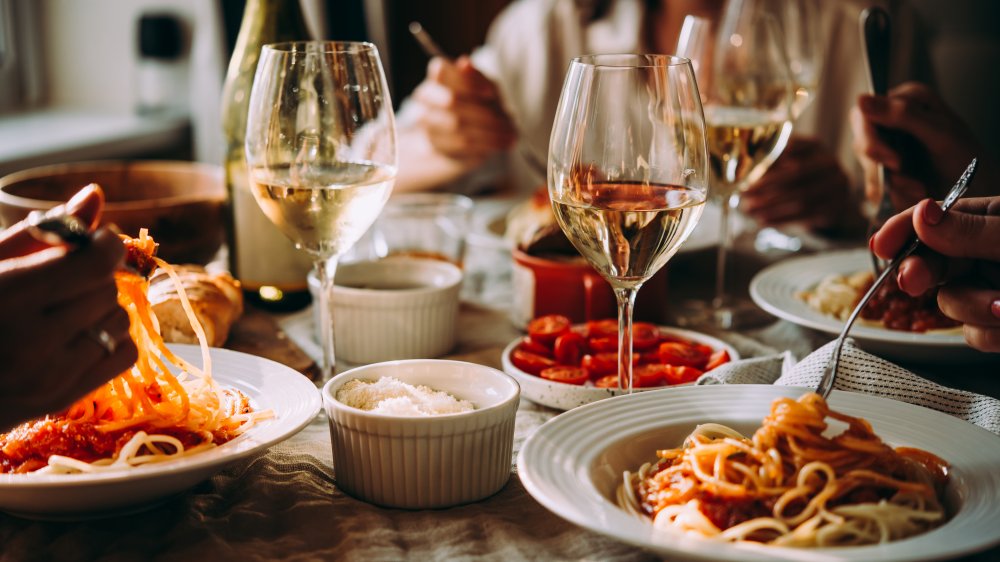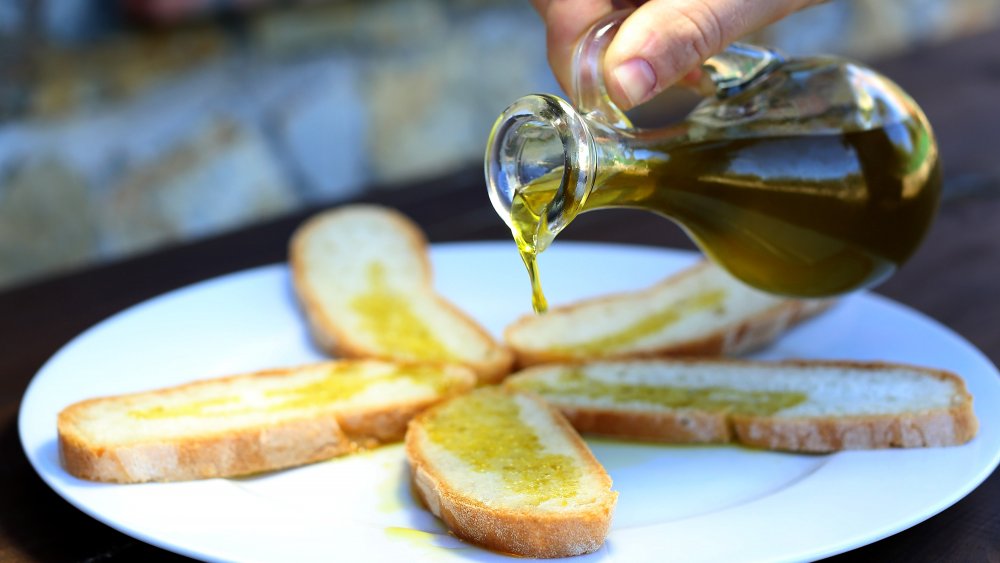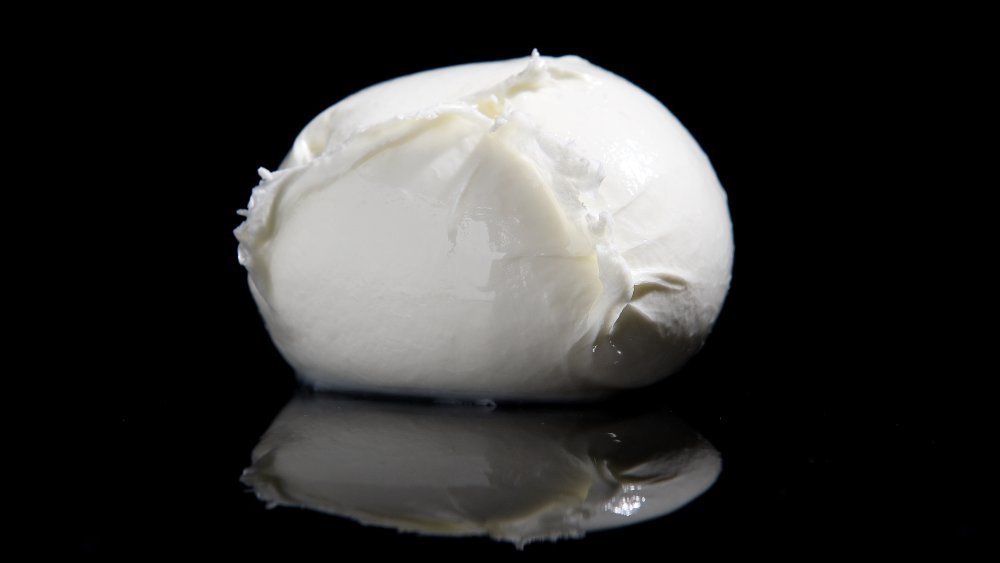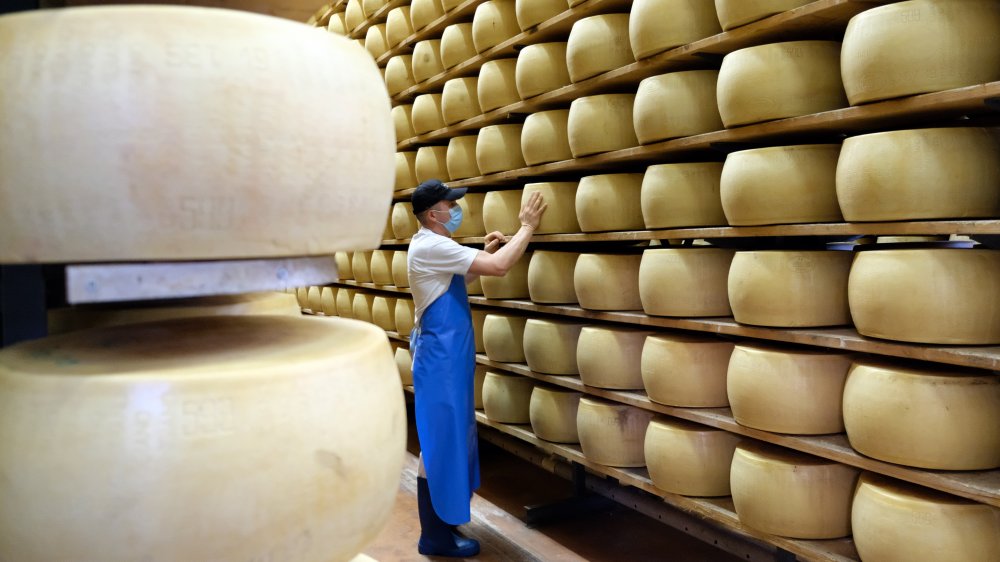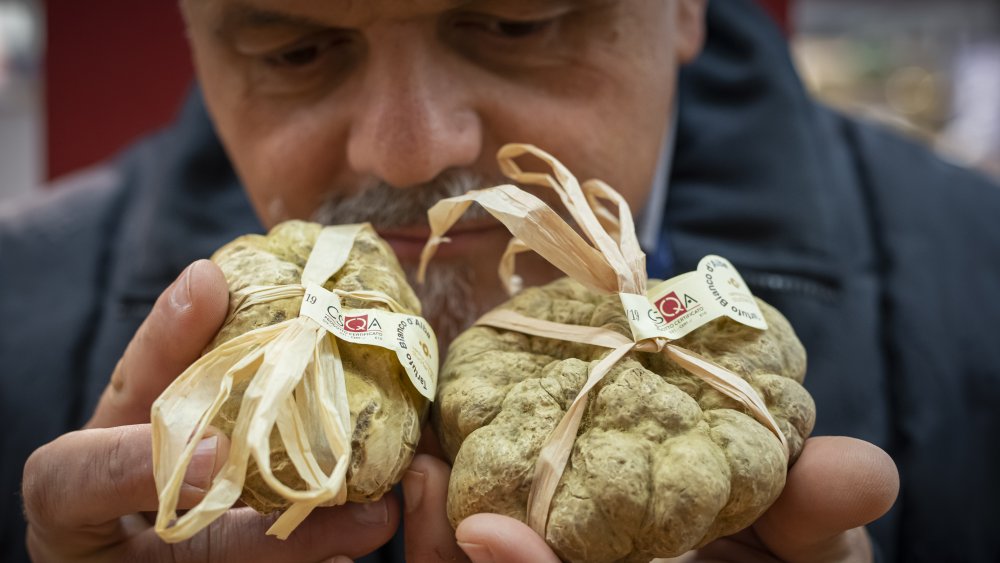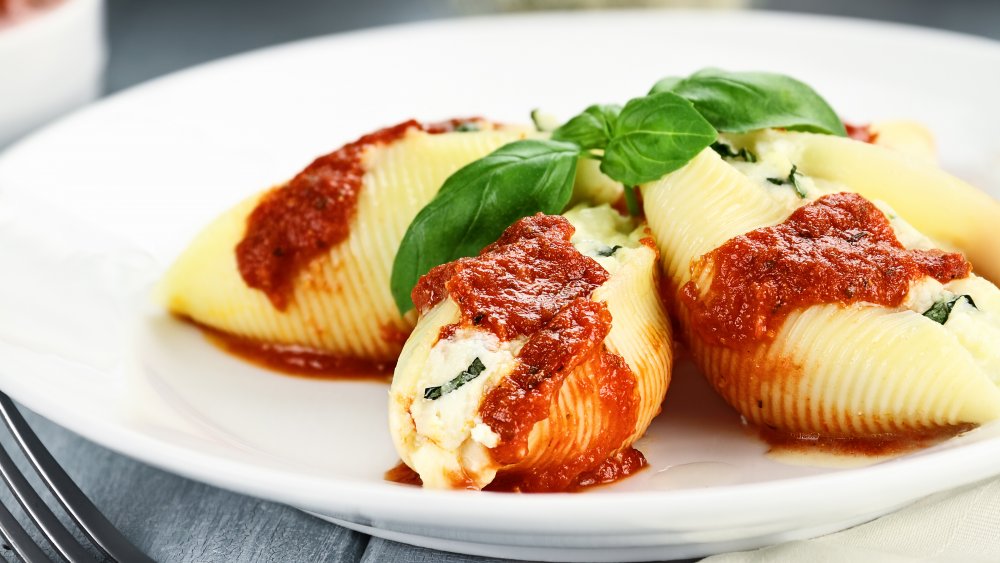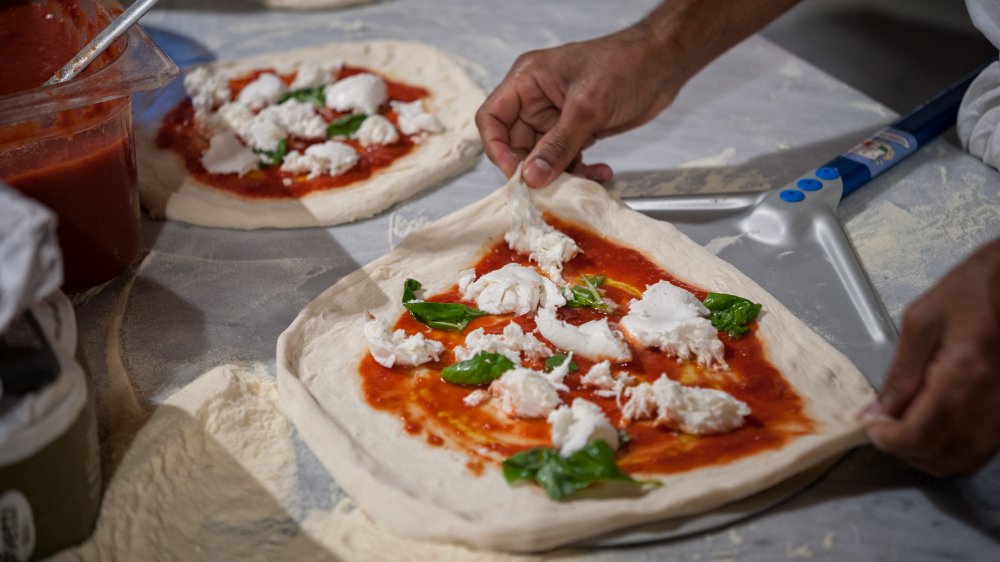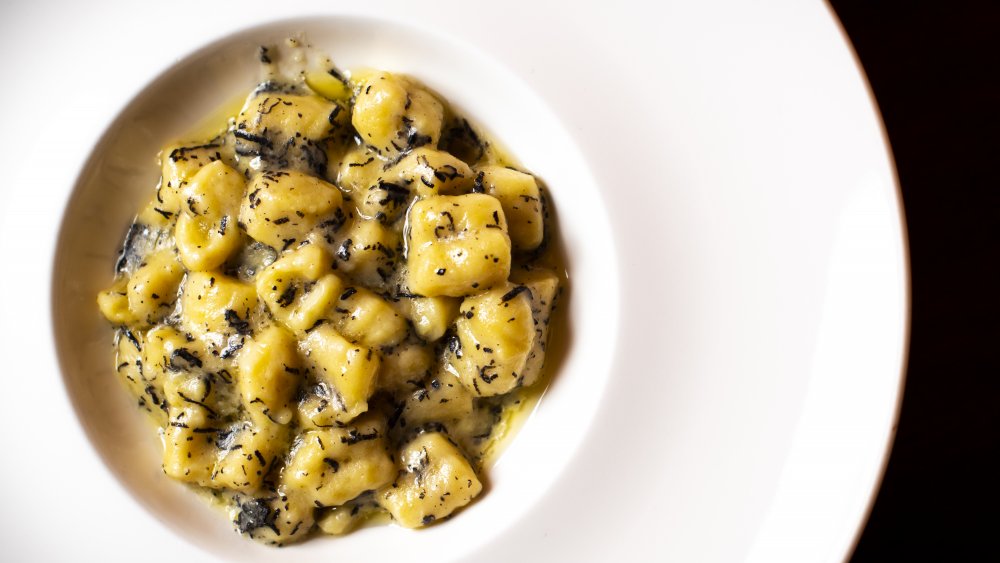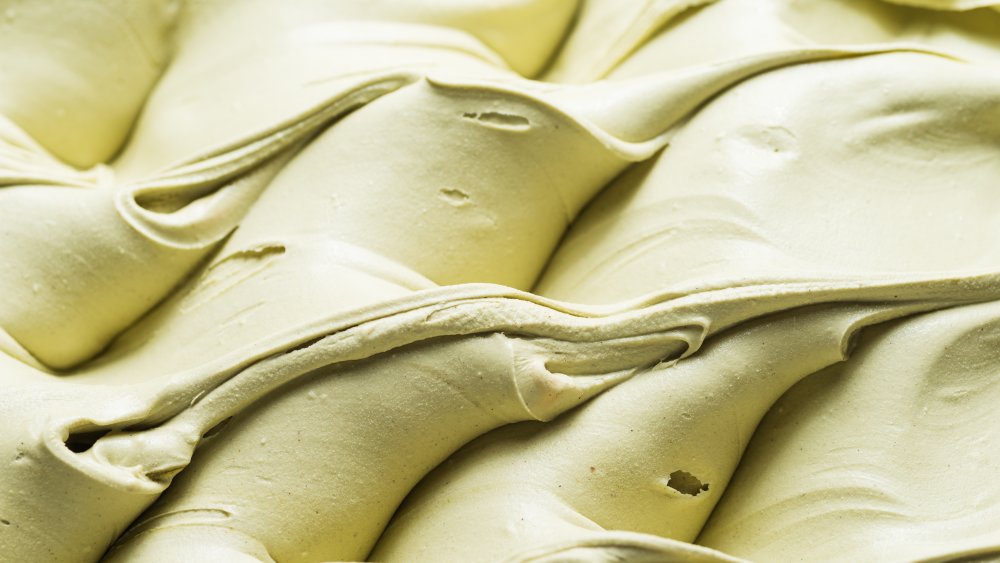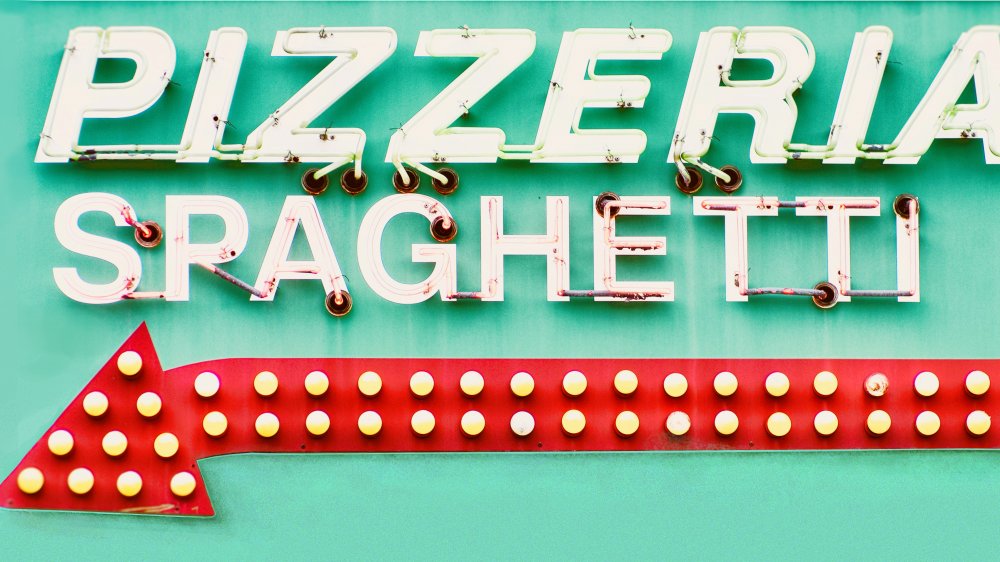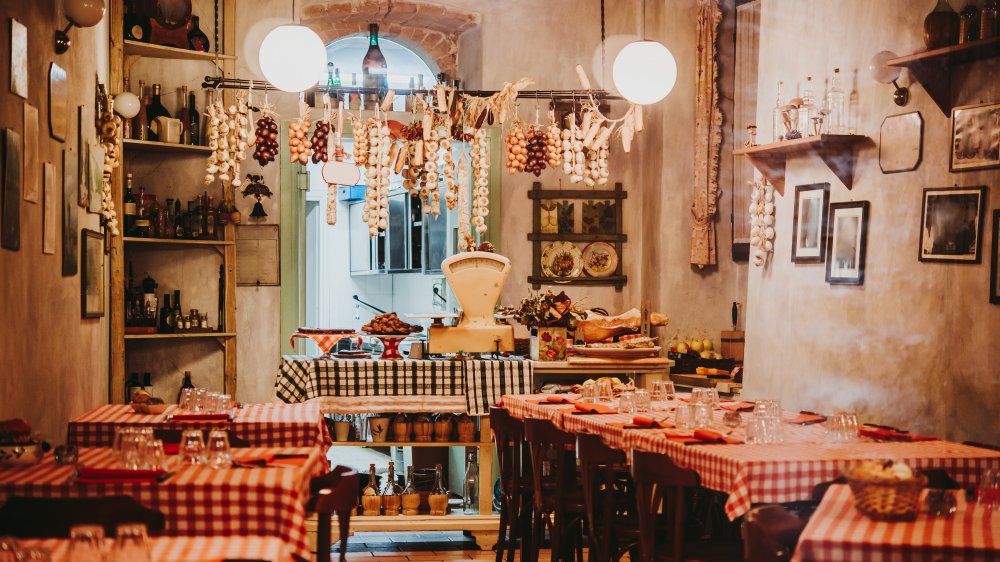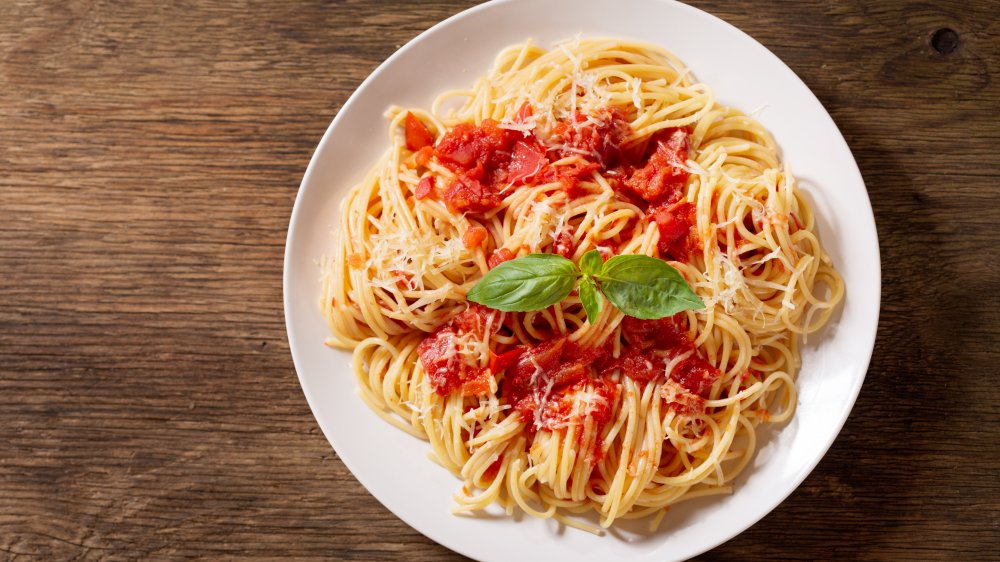Sneaky Ways Italian Restaurants Are Scamming You
Americans love Italian food more than any other international cuisine. While food critic and historian John F. Mariani stated the obvious back in 1989, the fact that he grew up spoiled by his Italian nonna's cooking makes him somewhat partial. More objective is a 2019 YouGov research study in which Americans gave Italian food a winning 88 percent score when it comes to most popular global cuisine (although pizza and pasta only narrowly beat out tacos and tortillas — Mexican food had an 86 percent popularity score).
All this love for Italian food has translated into moltissimo Italian restaurants across America. Options range from humble pizzerias serving the simplest of wood-fired pies to glitzy ristorantes in which the white truffle shavings on your pasta can set you back three digits — if they're even real. Unfortunately, along with highly addictive pasta, pesto, and Prosecco, some Italian restaurants — knowingly or not — are perpetrating scams that leave customers feeling fleeced and frauded, their stomachs full (albeit not necessarily with what they think), while their pockets are emptier than anticipated.
While some of the following scams are major and others are minor, they're all fairly common and quite sneaky.
Olive oil from Italian restaurants is (not) like a virgin
When you go to an Italian restaurant, it's likely the extra virgin olive oil you're drizzling onto your food isn't virgin at all. As The New York Times reports, most Italian olive oil flooding the world's market shelves "is neither Italian nor virginal." Instead, it's low quality, often from countries such as Syria, Turkey, Morocco, and Tunisia. Sometimes, it's not olive oil at all but a mixture of various vegetable oils camouflaged with artificial aromas and coloring such as chlorophyll and beta carotene.
According to an investigative report in Forbes, up to 80 percent of Italian olive oil on the market is fake. Chalk this high figure up to the Italian "Agromafia." With counterfeit olive oil offering profit margins as high as 700 percent, organized crime is moving away from cocaine into more lucrative and less risky "yellow gold."
While a restaurant may use a reputed Italian brand, many adulterated olive oils are sold under quality brand names. Even bottles stamped with Protected Designation of Origin (PDO) labels — which certify the contents hail from a renowned Italian olive oil region where they were subject to controls — can be subject to counterfeit.
Moreover, due to its high olive oil consumption, the U.S. is one of the world's biggest dumping grounds for fake olive oil. As Forbes concludes, unless a restaurant buys its olive oil directly from a producer or a certified distributor, its "Italian extra virgin" is likely a phony.
No buffalo in the bufala at Italian restaurants
It's hard to think about Italian food without conjuring up creamy, white mozzarella cheese that's a key ingredient in favorites such as insalata Caprese and pizza Margherita.
Recognized as the finest mozzarella of them all, mozzarella di bufala commands high praise (and prices) due its being made from the black-horned Asian water buffalo who mysteriously arrived in Central Italy's wet plains around 1000 AD. Richer than cow milk, buffalo mozzarella possesses a delicate, faintly sour taste and oozes a milky liquid when sliced.
Like many traditional Italian foods, mozzarella di bufala's origin and authenticity is guaranteed by a Protected Designation of Origin label. However, that doesn't stop counterfeit cheese from flooding the markets. In 2010, the Italian government carried out a nation-wide analysis of the beloved national cheese only to discover that 25 percent of samples contained cheaper, less rich cow milk. Despite the scandal that ensued, fake buffalo mozzarella production has increased. Counterfeiters aren't even discouraged by sophisticated technology such as the mass spectrometry test, which can detect the minute differences that distinguish cow protein from buffalo protein. In 2019, Food Manufacture reported that spectrometry testing conducted in British restaurants revealed that two-thirds of pizzas and other dishes — all supposedly prepared with mozzarella di bufala — were made partly or entirely from cow's milk.
Parmesan at Italian restaurants is not Parmigiano
In the dairy industry, Parmigiano-Reggiano is known as "The King of Cheeses." For over 800 years, this hard Italian cheese has been sliced, shaved, grated, and gratineed, served on its own or deployed to amp up the flavors and textures of untold dishes. The name alone is regal, but according to a Forbes article by Larry Olmstead, author of Real Food, Fake Food, most people will never get to taste it — even if they think they are.
The American translation of Parmigiano-Reggiano is parmesan. However, most parmesans are a far cry from the official PDO cheese consisting of three ingredients: milk (produced in Italy's Parma-Reggio region), salt, and rennet (a natural enzyme from calf's intestines). As Olmstead points out, the majority of "parmesans" available in the U.S. aren't made in Parma (or Italy) at all but in America. According to igourmet.com, in the U.S. the term "Parmesan Cheese" can be used as "a generic label for any hard Italian-style grating cheese made from cow's milk."
Consequently, it isn't a legal crime for an Italian restaurant to serve you parmesan posing as Parmigiano. However, it can be considered a culinary crime since the fake parm will likely be lacking in the distinctive umami kick that adds a flavor upgrade to so many dishes. Olmstead is mystified by restaurants that stick to imitation parm, explaining that the real thing is not that expensive and that "a little goes a long way."
White truffles at an Italian restaurant could be Tunisian fungus
Oprah loves white truffles so much that she carries a personal stash into restaurants, instructing chefs to shave the delicacy onto her meals. Since most of us aren't Oprah, we have to rely on restaurants' own stash of truffles when dining, which is a riskier proposition.
Truffles have ranked among the world's most treasured delicacies since Amorite kings were recorded craving them 4,000 years ago. Known as Alba or Piedmont truffles after their region of origin, Italian white truffles are the most prized due to their distinctive nutty taste and fragrant aroma, and that they can only be found in winter (by dogs, since pigs also succumb to truffle cravings). Like many coveted luxury items — a white truffle can cost between $2,700 and $6,800 per kilo — there is a massive black market for them.
In Eater, The Truffle Underground author Ryan Jacobs describes how roughly 75 percent of white Piedmont truffles don't originate in Piedmont or even Italy. The problem with truffles is that it's easy to be fooled by fake fungi. Unlike other famously falsified Italian foods, truffles aren't subjected to PDO controls and don't carry official stamps or labels. Without a perfumier's nose, the only way to distinguish a real white truffle from a fake is with a microscope or genetic analysis. As a result, according to Jacobs, many Italian restaurants, even sophisticated ones with stellar reputations, end up serving cheap Tunisian fungus instead of the Oprah-worthy original.
Watch out for hidden leftovers at Italian restaurants
When you're streaming your favorite food show, it's hard not to get excited by the ingenious things that top chefs can whip up with leftovers. However, such enthusiasm wilts when the leftovers in question are stealthily injected into the pricy entrée you ordered at an Italian restaurant.
If there were Ten Commandments of Italian cooking (which there are, thanks to The Guardian and Italian food doyenne Anna Del Conte), Commandment Number One would be the use of high-quality fresh ingredients. Seeing as most Italian ingredients are simple and inexpensive — tomatoes, basil, garlic — it should be the easiest commandment to comply with. Unfortunately, according to a panel of chefs who talked to Insider, some restaurants can't resist the lure of leftovers.
Italian-born chef Raffaele Dall'Erta warns against stuffed pasta shells, explaining that the large shells bathed in sauce are an ideal vessel for hiding fillings made from unused ingredients. If the shells are "on special," it's a giveaway that they're probably not so special at all, at least in terms of freshness.
Equally suspect are meatballs, particularly if camouflaged by spaghetti. Not only are meatballs magnets for leftovers, but according to chef Max Hardy, they're usually made ahead of time and aren't always fresh. For purists, it's actually somewhat of a scam for an authentic Italian restaurant to be serving spaghetti and meatballs in the first place since the dish doesn't even exist in Italy.
Margherita at Italian restaurants is not your friend
Another ubiquitous favorite at any Italian restaurant, pizza Margherita, does indeed have Italian bona fides. According to legend, when Italy's King Umberto and Queen Margherita made a royal visit to Naples in 1899, the queen, supposedly fed up with fancy French cuisine, requested some simple, unpretentious local fare. Her wish was the command of premier pizzaiolo Raffaele Esposito, who created a pie in the colors of the recently unified nation's flag: red (tomato sauce), white (mozzarella), and green (basil).
It was subsequently named after Her (happy) Highness. The tri-color pizza went on to become an edible Italian icon. However, that doesn't mean you should automatically order one. When Insider asked a panel of chefs to list the worst things to order at an Italian restaurant, Julia Helton, the former executive chef of an Italian restaurant, confessed that it's precisely the Margherita's simplicity that makes it one of the most overpriced items on any restaurant menu. As Helton sees it, being charged double digits for some dough topped with a bit of tomato sauce, a quarter log of mozzarella, and a few basil leaves is a "total rip-off." To satisfy your pizza craving, Helton recommends pies you can't easily make at home or order-in, preferably options that, wood-fired and topped with more unusual ingredients, are fit for a queen.
Gnocchi is a cheap filler-upper at Italian restaurants
It's believed that ancient Romans discovered gnocchi in the Middle East, where it was made from semolina flour. Back in Italy, they added milk, eggs, and parmesan to the dumplings and baked them into a dish known as gnocchi alla Romana. Northern Italians swapped out the semolina for homegrown spuds, creating gnocchi de patate, most commonly enjoyed today.
As FSR reports, the potato dumpling is becoming increasingly popular in the U.S. Yet the fact that gnocchi isn't quite as mainstream as spaghetti, ravioli, and risotto lends it a certain cachet. Its relative unusualness, coupled with the time and dexterity required to make gnocchi, seemingly allows some restaurants to feel justified in charging elevated prices or serving pre-packaged varieties. An example of such "corner-cutting" was (unpleasantly) experienced by a Portland Press Herald food writer who reviewed an Italian restaurant that prides itself on serving "truly authentic" Italian cuisine.
Even when gnocchi is freshly made, because it's a heavier, more filling dish, some restaurants see it as an inexpensive antidote to more pricey, protein-packed options. As Don Odiorne, vice president of food service for the Idaho Potato Commision tells FSR, chefs have increasingly turned to potato gnocchi as a way to offset elevated meat prices. Inverting the old meat-and-potatoes formula, many restaurants are increasingly offering more affordable (for them) potato gnocchi with a euphemistically "petite portion" of meat on the side.
How artisanal is your gelato at Italian restaurants?
After a rich Italian restaurant meal, who doesn't have the urge to scream for a palate-cleansing gelato? If you knew how much your gelato is marked up, you'd scream even louder.
As The New York Times asked, is there a good reason why ice cream — whose inexpensive foundations are milk, sugar, and eggs — costs more than prime rib-eye steak? A popular justification for expensive gelatos is that they're "artisanal." However, the term's meaning is vague. Adding water to a dry mix may be considered "artisanal" gelato.
In theory, what distinguishes gelato from ice cream is that it contains less air, which translates into intense flavors, dense textures — and higher prices. However, as The Times points out, the cost of ingredients and the amount of air in a gelato contribute little to its overall price.
Even in Italy, there are plenty of gelaterias that sell their frozen wares as "artigianale," even though their gelato is neither fresh nor handmade. When Conde Nast Traveler asked Italian food experts to provide tips on spotting fakes, the experts said the most detectable sign of artigianal-ity is color. Bright green pistachio and lipstick-red strawberry scream of artificial coloring (and possibly flavoring). Natural ingredients yield more muted and earthy colors. According to the experts, banana is the litmus test flavor — the real artisanal deal should skew more elephant grey than canary yellow.
Getting drunk on wine markups at Italian restaurants
Italy is as justly famous for its wines as it is for its food. As satisfying as a glass of Chianti or plate of ravioli are on their own, to paraphrase Aristotle, the whole meal is greater than the sum of its parts.
The problem stems from the final bill — whose sum, as Insider warns, is sure to be mildly-to-outrageously inflated by the wine markup, especially if you opt for a glass instead of a bottle (which gives you comparatively more buzz for your buck).
Italian restaurants claim charging high prices for (optional) wine allows them to reduce prices for food. They also argue that selecting, suggesting, pairing, opening, and serving wine all add value to the drinking experience. Yet as Newsweek points out, diners generally fork out between two to four times more for a bottle than the price they'd pay at a liquor store. And unlike preparing food from scratch, all that's required of bottled wine is to open and serve it. Yet knowing how conditioned (and eager) we are to want wine with our pasta, restaurateurs also know we'll pay (dearly) for the privilege.
Recently, scam salvation has arrived in the form of apps that allow diners to swipe and see exactly how much they're being stiffed on any given bottle. According to Wine Searcher, such apps have favorably impacted the "shrinking but still-existing firmament of rip-off merchants." Aristotle, who ritually enjoyed wine at his symposiums, would doubtlessly approve.
Mind your language at Italian restaurants
In "Commodified Identities: The Myth of Italian Food in the United States," author Davide Girardelli discusses some Italian restaurants' deliberate and misleading use of real and fake Italian terms to coax American consumers into believing they're eating vero Italian food. As Girardelli points out, as Italian food has exploded in popularity, some restaurateurs have sought to profit by selling "Italianicity." Girardelli cites National Restaurant Association research that found that one main aspect of Italian food that attracts American consumers is its "authenticity," i.e., "authentic" Italian dishes instead of "Americanized" substitutes.
Italian restaurants lacking in "Italianicity" — for example, those without native Italian or Italian-speaking or trained owners, cooks, or staff — have found subtle if sneaky ways of creating "authenticity." One of them is to actually use the word "authentic." Customers can see this ploy at work upon entering restaurants such as Fazoli's, where a gold-framed mission statement promises "authentic Italian favorites."
Another strategy is the use of Italian words — real or not. Girardelli gives the example of Fazoli's, whose signage and menu prominently display Italian words such as "ziti" and "lasagne." The restaurant goes further, however, by using fake Italian words such as "submarino" — although neither the term nor the sandwich it designates is Italian. Even the name Fazoli isn't real, although it certainly sounds Italian. Such tactics not only create a counterfeit Italian experience but also subliminally justify inflated prices for a (non) authentic Italian meal.
Fake trappings of authenticity at Italian restaurants
Aside from language, many Italian restaurants rely on subtle aesthetic and decorative strategies to up their Italian cred in diners' minds. The most obvious and widespread tactic is the use of the national colors of red, white, and green in everything from signs and logos to menus and decor. As French philosopher and semiotician Roland Barthes pointed out in Image, Music, Text, using the colors of the Italian flag is a basic strategy that communicates "Italiancity."
According to the National Restaurant Association findings cited by author Davide Girardelli, a majority of American consumers love Italian food for its down-to-earth "simplicity" and Old World "rusticity." To feed customers' fantasies (and potentially pad their bottom line), many restaurants comply with these expectations in myriad ways. They decorate restaurant walls with antique, black-and-white or sepia-toned photos of the Old Country and display portraits (real or imaginary) of earthy Italian mammas and nonnas, suggesting to customers that food is made according to traditional family recipes passed on through generations.
Exposed brick, unvarnished wood, and wood-burning stoves — as well as candles or dim lamps — conjure up country farmhouses and old-fashioned family kitchens. Images or even live displays of fresh vegetables — plump red tomatoes, white garlic, green herbs — further underscore Italianicity while communicating to diners that the restaurant uses only fresh, high-quality Italian ingredients. Immersed in so much carefully curated Italianness, you'll be primed to enjoy — and pay for — your "authentic" meal.
Deceptive simplicity at Italian restaurants
You might think it's a good idea to order a simple pasta dish at an Italian restaurant. In terms of taste satisfaction, this might be true. However, in terms of economics, it's a bust. Business Insider concedes that spaghetti with fresh tomato sauce might hit the spot, but argues you'd be a fool to pay a huge percent markup for a dish that even the most challenged cook can easily (and inexpensively) make at home.
The same goes for cacio e pepe: pasta with black pepper and pecorino cheese. As chef Linda Harrell confesses to Insider, in Italy the no-nonsense dish is a go-to if you lack time or ingredients to make a real meal. Unworthy of being served in a restaurant, she recommends American diners skip it since it isn't worth the money.
Then there's fettuccine alfredo, which mingles parmesan with cream and butter. Italian chef Raffaele Dall'Erta scorns this classic for being " a very lazy pasta dish" which anyone can make at home. Meanwhile, The Guardian notes that while fettuccine alfredo has become a staple in many American restaurants "that brand themselves Italian," it doesn't exist in Italy. Its closest relative is pasta with butter and parmesan, which Italians whip up at home but would never dream of ordering in a restaurant. The fact that it's so carelessly tossed together explains why it's called pasta del cornuto "cuckold's pasta," insinuating that whoever prepared it was distracted by other, more important (romantic?) pursuits.
